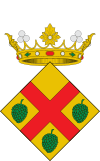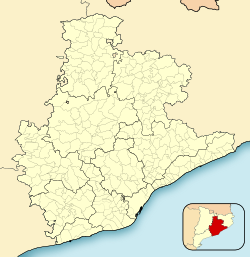Gironella
| Gironella | |||
|---|---|---|---|
| Municipality | |||
 |
|||
|
|||
| Location in Catalonia | |||
| Coordinates: 42°02′N 1°53′E / 42.033°N 1.883°ECoordinates: 42°02′N 1°53′E / 42.033°N 1.883°E | |||
| Country |
|
||
| Community |
|
||
| Province | Barcelona | ||
| Comarca | Berguedà | ||
| Government | |||
| • Mayor | David Font Simon (2015) (CiU) | ||
| Area | |||
| • Total | 6.8 km2 (2.6 sq mi) | ||
| Elevation | 469 m (1,539 ft) | ||
| Population (2014) | |||
| • Total | 4,987 | ||
| • Density | 730/km2 (1,900/sq mi) | ||
| Demonym(s) | Gironellenc, gironellenca | ||
| Website | gironella |
||
Gironella is a municipality in the comarca of the Berguedà in Catalonia, Spain. It is situated in the left bank of the Llobregat river to the south of Berga. The local economy is traditionally based on cotton spinning and textile manufacture, although tourism is now more important: the company towns or "colonies" of workers houses surround the cotton mills are of historical interest.The town is served by the C-16 road to Berga and the Cadí tunnel. Gironella, which has numerous stores, bars, and schools, is an important economic center for the smaller towns around it, such as Olvan, Sagàs or Casserres.
The town is mentioned in a well-known traditional Catalan song, A Gironella or Cançó de Gironella, in which a young man laments being rejected by his beloved and being forced to leave the town behind.
No prehistoric archeological sites have been found in the municipality of Gironella therefore no traceability to ancient times has been possible. However, Rosa Serra states that the situation of the inhabitants of Gironella should have been the same as the people living in the area of Baix Berguedà.
Human habitats have been found in the region from Neolithic and there are several Iberian sites (Puig-reig, Santa Maria de Merlès, Montclar, L'Espunyola, Berga, Casserres etc.). During the restoration of the old church of Santa Eulàlia of Gironella, pottery remains belonging to different times were found.Among them, there was a local Iberian piece of ceramic and another belonging to Roses workshop, both dating from before the third century BC. This finding shows the settlement in the area from the protohistoric times.
...
Wikipedia




